Top>HAKUMON Chuo [2014 summer Issue]>Save the children from poverty
 Index
Index
Close up
Save the children from poverty
Promising education in high school and university
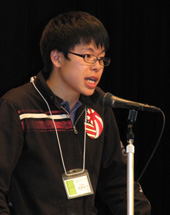
Ryohei Takahashi, 3rd-Year Student at Chuo University / Scholarship student of Ashinaga (NPO)
One in every six children in Japan grows up in poverty. Half of single-mother households have an annual income of 1,200,000 yen or less.
Children are forced to forgo high school and university due to economic reasons.
Furthermore, a negative spiral prevents the next generation of children from obtaining further education.
Ryohei Takahashi, a 3rd-year student at Chuo University, decided to take a stand and reform these unacceptable conditions.
Ryohei is Executive Chairman of “Stop! Children’s Poverty,” a student association sponsored by the NPO Ashinaga.
1.My experience
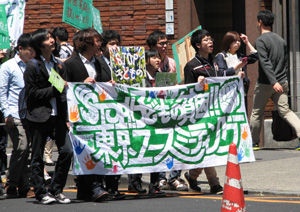
Ryohei (3rd from left) raises his voice while marching at the front of a parade
2.Reality of child poverty
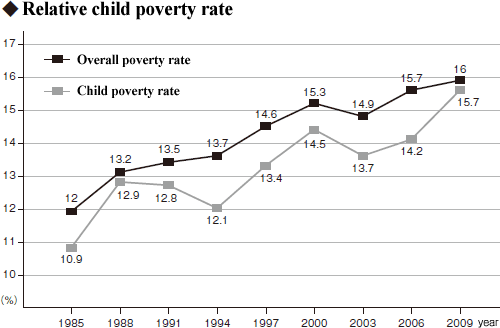
Source: Comprehensive Survey of Living Conditions, Ministry of Health, Labour and Welfare
(Notes)- 1. As based on OECD formulation standards, the relative poverty rate is calculated using the ratio of household member who are less than half of the median for equivalised disposable income (income calculated by dividing the disposal income of a household by the square root of household members.
- Numbers for 1994 exclude Hyogo Prefecture.
- “Adults” refer to those 18 years and older. “Children” refer to those 17 years and younger. The “working generation” refers to households in which the head of the household is 18 to 64 years old.
- Excluding households with unknown equivalised disposable income.
ⅰ)Child poverty rate / Single-parent poverty rate
ⅱ)Opposite function of income reallocation
An increasing number of children are being denied a normal lifestyle. Compared to other children, children in poverty face major disadvantages when starting out in life. The “relative child poverty ratio” (see graph on left) indicates the ratio of children living at an income which is half or less of the average household. According to a 2009 survey by the Ministry of Health, Labour and Welfare (MHLW), this ratio reached 15.7% and is increasing annually.
In particular, the relative poverty rate for single-parent households is 50.8%, the worst among developed countries (according to MHLW survey). This is despite the fact that more than 80% of single parents are employed. This high poverty ratio is caused by insufficient functioning of income reallocation by the government, as well as by a work environment which places single parents at a disadvantage.
3.Higher education and sacrifice by a family member
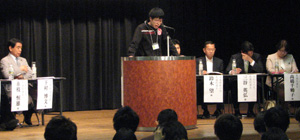
Ryohei stands at the podium and speaks for Stop! Children’s Poverty. At left is Hakubun Shimomura, Minister of Education, Culture, Sports, Science and Technology
Child poverty causes a great discrepancy in education, thus creating a “poverty chain” in which poverty is inherited by children from parents.
Today, children living in economically-challenged households are only able to obtain higher education through the self-sacrifice of a family member.
Emotionally and physically, mothers and fathers drive themselves into the ground for their children. Older sisters and brothers forgo higher education, give up their dreams and start working for the good of their younger sisters or brothers.
Even on an international perspective, sacrifice by a family member is required to pay the high tuition fees of university, colleges and vocational schools.
4.Impossible to study
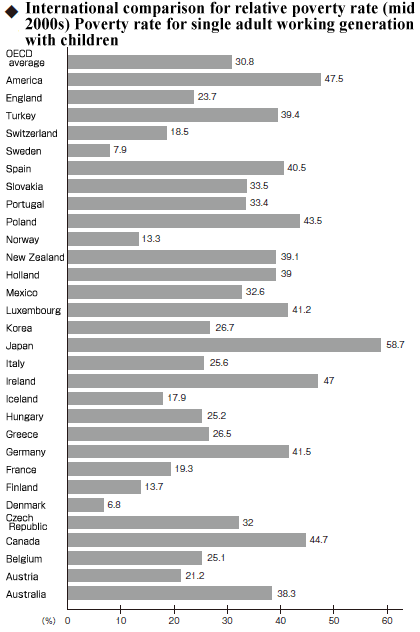
(出典)OECD(2008)“Growing Unequal? INCOME DISTRIBUTION AND POVERTY”
In addition to economic difficulty, poverty deprives children of the motivation and academic ability needed to enter universities and other institutions of higher learning.
Food, health and an environment conducive to concentrating are prerequisites for studying. Beginning from financial poverty, child poverty destroys the conditions necessary to concentrate on their studies.
Today, taking 3 meals a day, having a personal desk for studying, and going to cram schools are all commonplace for students. Poverty deprives many children of such opportunities.
5.Tokyo Youth Meeting
The Law on Measures to Counter Child Poverty was enacted on January 17th, 2014. In July, the Japanese government planned to formulate general principles which embody the ideas of the law. The content of these general principles will determine the effectiveness of future measures to combat child poverty.
On May 17th, university students held a student rally entitled Tokyo Youth Meeting at the Nippon Seinenkan in Sendagaya, Tokyo. The meeting was mainly comprised of students from 12 groups from throughout Japan. Students drafted Youth Meeting Guidelines and presented them to representatives of each party in the Japanese national diet.
6.Youth Meeting Guidelines
The most important theme is to thoroughly expose the often unrecognized issue of child poverty. It is necessary to strongly advance child poverty surveys and research, fields which are lagging when compared to England and the United States, as well as to comprehensively assess the conditions of child poverty.
It is also essential to establish numerical targets for goals which are surveyed. Moreover, we must ensure that effective measures are taken. It is important to set goals for reducing the child poverty rate and single-parent poverty rate which were previously discussed.
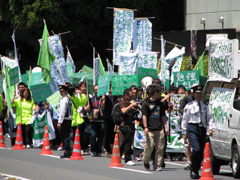
Furthermore, it is necessary to perpetuate the meeting to review child poverty measures, a group in which I currently participate. We must establish a Council on Child Poverty Measures.
In order to incorporate the social needs of children, we must create a system for enabling children themselves to participate in the review and verification of measures.
I hope to create a Child Poverty Measures Fund which will receive funding not only from the government, but also from a wide range of private sources. It is important to establish a system which allows society as a whole to support regional activities such as academic support and after-school programs run by NPOs which have gradually evolved even while struggling to procure financing.
7.Children are the future
Children are the future. We university students are members of the current society. We can greatly contribute to protecting Japan’s future by taking repeated and diligent action.
Right now, there are children who are neglected and alone. This means that the future of Japan itself is being neglected. Now is the time for university students to show our true strength.
Ryohei serves as Executive Chairman of Stop! Children’s Poverty. At the association’s Tokyo Youth Meeting (May 17th), orphaned high school students, former foster children who received foster care and single mothers speak on current conditions.

Parade on a sunny Saturday
The average annual income of single mothers is 2,230,000 yen. For single fathers, it is about 3,600,000 yen. My older brother’s life changed when he borrowed money from black-market lending. He labored for low wages and ultimately committed suicide rather than endure his exhaustion.
By sharing private matters which are best kept to myself, it is my heartfelt wish to save children who have given up on higher education for economic reasons. Education is necessary to escape from poverty. I truly hope that we can build a society which offers education to all.
Members of the audience listened intently, some of them in tears.
The next speaker was Hakubun Shimomura, Minister of Education, Culture, Sports, Science and Technology. Speaking haltingly, Minister Shimomura explained that he was a member of Ashinaga’s first graduating class. He discussed the difficulties of his life as a student and expressed his support for the activities of students in the Stop! Children’s Poverty group.
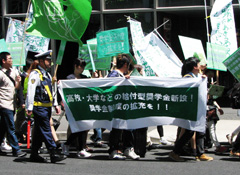
After the speeches, students embarked on a parade starting from the Nippon Seinenkan in Sendagaya, Tokyo and proceeding to Gaiemmae, Omotesando, Meiji-Jingumae, and Jingu-Dori Park. The sound of fans cheering for a Tokyo Big 6 Baseball League game could be heard from the nearby Jingu Stadium. Raising their voices to overcome the cheers, Ryohei shouted the slogan of “save children from poverty!”
The following passage by author Jiro Akagawa was published in Tosho, a PR magazine of Iwanami Shoten Publishing.
“Today, Japan has become a frighteningly cruel society towards the disadvantaged. In particular, the issues of child poverty and an annual income of 1,200,000 yen or less for half of single-mother households—these issues should be unthinkable for a civilized country. (Omitted) If a child’s only proper meal each day is school lunch, what kind of dreams can that child have for the future?”
More information on Ashinaga support activities
■Lobbying for enactment of laws
Beginning from the Nationwide Conference of Orphaned Children and Single Mothers held in December 2009, University and vocational school’s scholarship students of Ashinaga lobbied every year for the enactment of the Law on Measures to Counter Child Poverty.
■10,000 yen dormitory fees
Through dormitory fees of only 10,000 yen (including breakfast and dinner), Ashinaga supports the university studies of orphaned children from households on welfare. The association operates student dormitories in Hino City (Tokyo) and Kobe City.
■1,530 university students
In the 2014 academic year, Ashinaga plans to loan total scholarships of 2,368,500,000 yen to 5,677 students. The breakdown is as follows: 3,750 high school/technical college students, 1,530 university students, 370 vocational/miscellaneous students, and 27 graduate students.
■40,000 yen monthly loan
Ashinaga issues a monthly loan of 40,000 yen as a scholarship to university students (including students at 2-year colleges). Graduate students are issued a monthly loan of 80,000 yen as a scholarship.
- Research Activities as a Member of Research Fellowship for Young Scientists (DC1), Japan Society for the Promotion of Science (JSPS) Shuma Tsurumi
- Important Factors for Innovation in Payment Services Nobuhiko Sugiura
- Beyond the Concepts of Fellow Citizens and Foreigners— To Achieve SDGs Goal 10 “Reduce Inequality Within and Among Countries” Rika Lee
- Diary of Struggles in Cambodia Fumie Fukuoka
- How Can We Measure Learning Ability?
—Analysis of a Competency Self-Assessment Questionnaire— Yu Saito / Yoko Neha - The Making of the Movie Kirakira Megane








